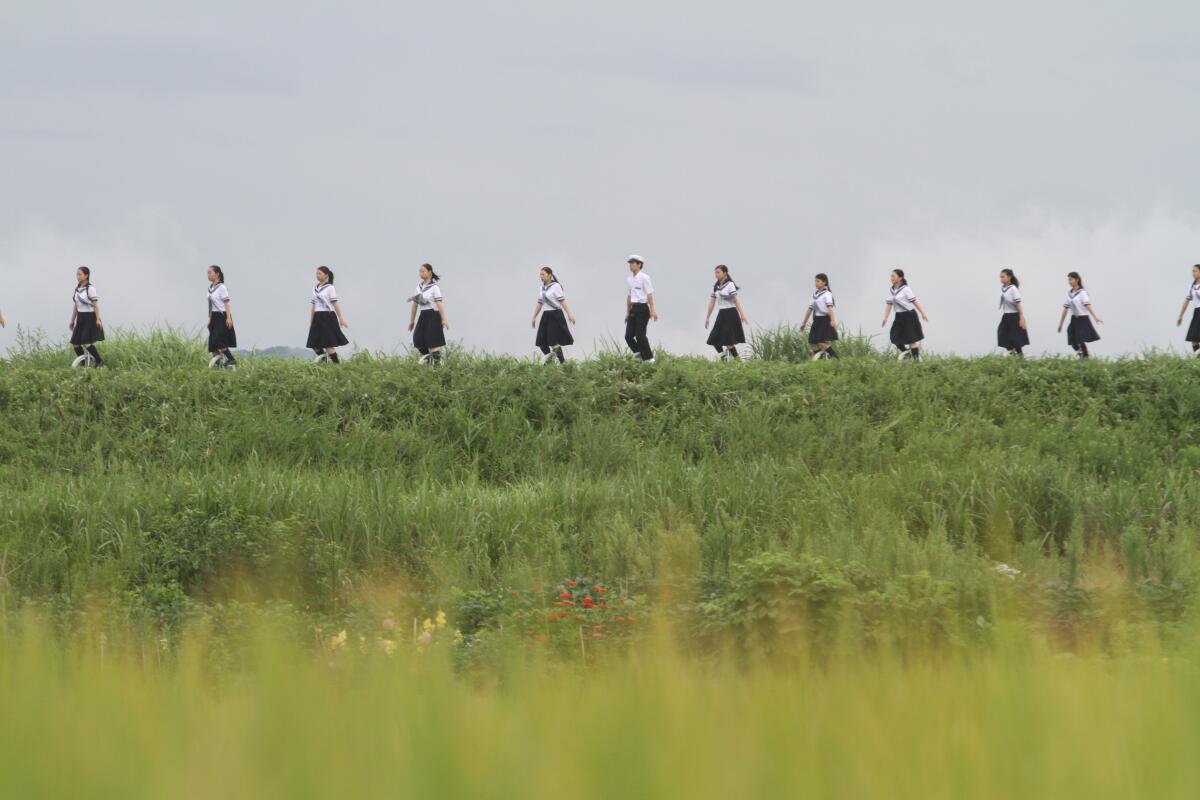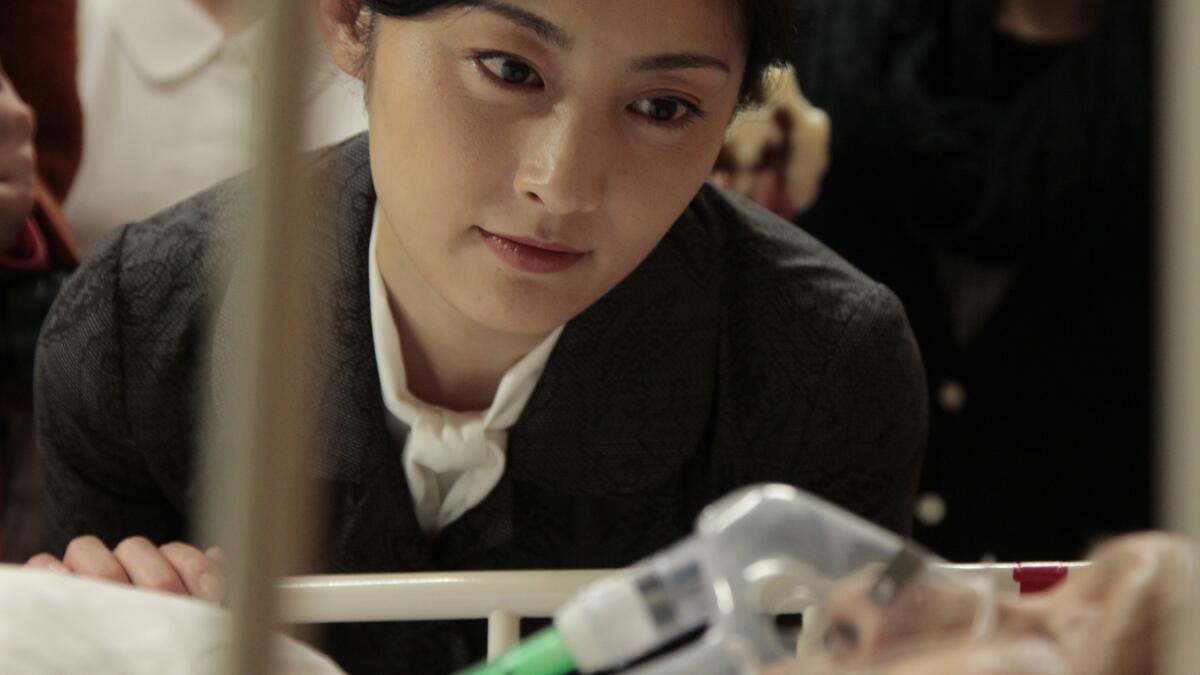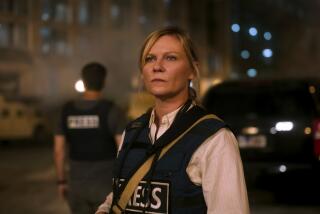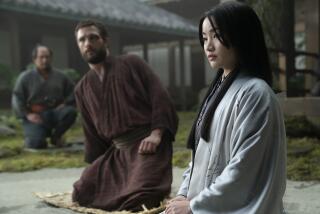Review: Nobuhiko Obayashi’s ‘War’ trilogy captures the delirious nature of being

Can an antiwar film be colorfully playful? Can kitsch promote healing? Can the most artificial of effects techniques hold the deepest of truths? These questions get a workout when watching Japanese surrealist master Nobuhiko Obayashi’s trio of war-themed films from the last decade of his life — “Casting Blossoms to the Sky” (2012), “Seven Weeks” (2014), and “Hanagatami” (2017) — and are also another way of realizing that one shouldn’t approach his work with preconceived notions of what type of cinema best tells which types of stories.
His is not an oeuvre to categorize — built of green screen and melodrama, steeped in bold imagery and fast cutting — but rather to submit to, like a hand-crafted fair ride both rickety and transporting. Obayashi, who died last year at the age of 82, is best known for his first feature, 1977’s “Hausu” (“House”), a demonic playdate with childlike horror, memorably fueled by a dreamlike bizarro-pop aesthetic that merged his avant-garde beginnings with the flashy sensibility of his years in advertising. Though that film’s reputation over the years gave him a name in cineaste circles, his prolific output across many genres nevertheless touched on serious, abiding concerns, usually with an understanding of the past, and how that journey often pits personal healing against the tide of history and its consequences.
For Obayashi, a child of World War II who grew up a committed pacifist, that particular past is Japan’s legacy of militarism, war, atomic bomb trauma and revival. When the country was devastated once more in 2011 after the Tohoku earthquake, tsunami and Fukushima nuclear catastrophe, Obayashi — who had been slowing down his career — was spurred to honor the enduring nature of Japanese people when emerging from disaster. That became the documentary-fiction hybrid “Casting Blossoms to the Sky,” the first of what would become known as his “War” trilogy.
“Casting” follows a Nagasaki-born female journalist (Yasuko Matsuyuki) drawn by a letter from an ex to visit the town of Nagaoka, site of an annual fireworks celebration honoring those who perished in the U.S. military’s devastating bombing of the city in 1945. Her trip is multipurpose: to gather experiences from survivors and hear stories about tsunami recovery, but also to see the town’s annual fireworks celebration and a play about the war staged by her former flame and written by an enigmatically wise student of his with her own mysterious link to the elderly woman at the tragic story’s center.
A ghost story folded into a town portrait, dotted with romance and history lessons — including a powerful, poetic ode to the otherworldly, consoling beauty of fireworks as a sort of “anti”-bomb — “Casting” is Obayashi in hopeful, even sentimental mode about the salve of community when wounds run deep. Like the arresting image of a schoolgirl weaving among citizens on a unicycle, it’s a stylistic, emotional balancing act unlike anything else you’re likely to see.
He then turned to the legacy of the war within a family, creating the dialogue-heavy, rapid-paced drama “Seven Weeks,” set in the former mining town of Ashibetsu, to explore the ways death is both an end and a beginning. When 95-year-old physician-artist-war veteran Mitsuo (Toru Shinagawa) dies, his relatives gather for the titular Buddhist mourning period. Amid remembrances and squabbles, surrounded by the keepsakes that defined Mitsuo’s life — and jarred by the weighted presence of a mysterious, palpably sorrowful former nurse (the compelling Takako Tokiwa) — his descendants discover that their beloved patriarch held scars, secrets and regrets.

Densely structured and replete with the sublime-to-surreal visual touches that are Obayashi’s cinematic oxygen, “Seven Weeks” is a dark jumble of trauma and rebirth. But what makes it resonate is how Mitsuo’s (read: Japan’s) history and his family’s present is layered over the nearly three-hour running time: like a temporal lesson in how confronting loss — finding its place in one’s narrative — is what allows for later peace.
Where “Casting” and “Seven Weeks” depict the healing power in creating art — theater and painting, respectively — the third part of his loose trilogy, the feverish, hallucinatory period dream “Hanagatami,” feels like the therapeutic art Obayashi himself needed to make after receiving a terminal cancer diagnosis at 80. (His adaptation of Kazuo Dan’s 1937 novella was a long-unrealized project, originally intended to be his feature debut in the ‘70s instead of “Hausu.”)

Set in 1941 in the seaside town of Karatsu, it depicts the roiling passions and ideological clashes in a sextet of teenagers (three boys, three girls) on the brink of losing it all to war. From fast friendships to budding romances to unnerving bonds, Obayashi paints youth in wartime as a death sentence worthy of the most operatic moonlight, boldest of colors and stylistically frenzied image-crashing climaxes.
Latching on to Obayashi’s wavelength can be disorienting, especially when his care, his humanity, is set against so fragmented a visual approach. But as his “War” trilogy expresses, the movies teach you how to watch them, not unlike a storybook. Take his love of green screen, at the forefront of his personal style. In an oddly innocent, poignant way, its very essence as a classic cinema process mirrors our relationship to memory — the human foreground, the changeable background, two places in one space, dimensions of real and unreal, off-putting yet magical.
Obayashi understood that delirium better than most, and it’s at the heart of why his trilogy is so idiosyncratic and unforgettable about how we examine the past, live in the present and look toward the future.
Tragedies of Youth: Nobuhiko Obayashi’s War Trilogy
In Japanese with English subtitles
Not rated
Running times: “Casting Blossoms to the Sky,” 2 hours, 40 minutes; “Seven Weeks,” 2 hours, 51 minutes; “Hanagatami,” 2 hours, 49 minutes
Playing: Starts July 9, Laemmle Virtual Cinemas
More to Read
Only good movies
Get the Indie Focus newsletter, Mark Olsen's weekly guide to the world of cinema.
You may occasionally receive promotional content from the Los Angeles Times.






